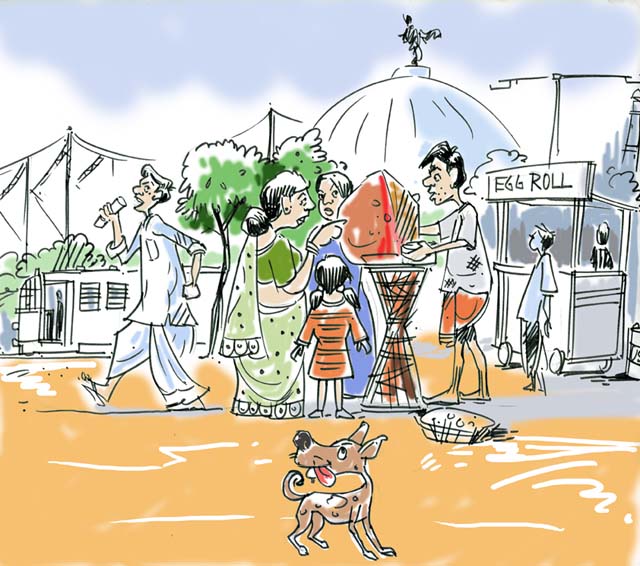
Bengali-Americans and Kolkata’s Food Delights
For those who’ve lived in and loved Calcutta – or Kolkata as it’s now known – feasting is an important part of life. Here four Bengali-Americans share their best memories of the city’s innumerable, incomparable eats: Partha Banerjee, NY activist, talks of his favorite haunts in his favorite city; Mukti Banerjee, home cook, shares some delicious Bengali food through her meetup group in Brooklyn; Kriti Mukherjee, foodie and consultant reflects on the importance of food in a Bengali’s life, and businesswoman Priyashmita Guha shares a tale about eating street foods with her father in Maddox Square.
Kolkata Street Foods:
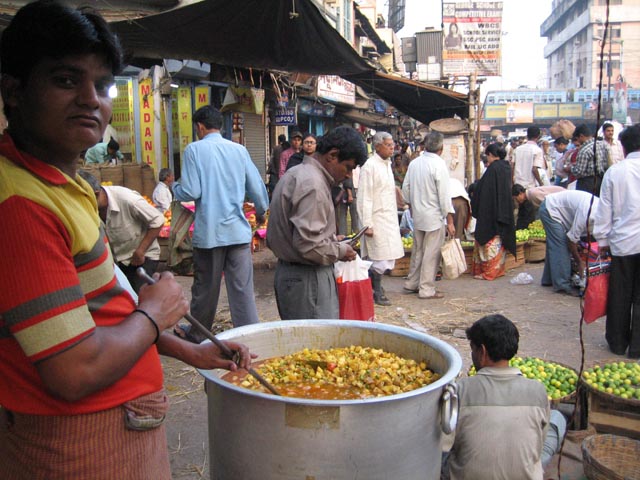
Partha Banerjee, NY activist and writer: On the Street foods of Calcutta which he and his wife Mukti relished during college days when the appetites were big and the budget was little.
Best treats for the locals: Aloo-Kabli (potato with chickpea mixed with various salts and tamarind paste); puri kachori; samosa; Phuchka (pani puri) on a hot summer day; Pakora (fritters) made of eggplant, onions, cauliflower, etc. with besan (chana powder) and hot chutney; Papad on a rainy evening, like the Rath Yatra evening; Mutton roll from small dhabas , Mughlai Paratha at Esplanade’s Anadi Cabin
And then there are so many small, roadside restaurants that we often visited — like Lahore Restaurant for roti and chicken curry, or maybe, occasionally, Madras Dosa. On sizzling summer days, kulfi with rice noodles and rose syrup at Rally Singh in Esplanade next to the Metro Cinema.
Rally Singh is still there, and so is Anadi Cabin. Lahore Restaurant on S. N. Banerjee Road next to Elite Cinema is gone.
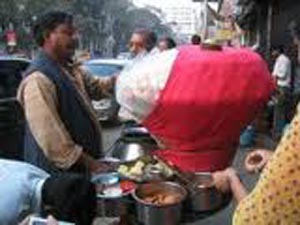
Best treats for the tourists: They must try the fish dishes and Bengali sweets – these are the two things Bengali cuisine is perhaps the most famous for. Nowadays, the small places in Kolkata are not doing very well. Instead, there are many new fancy places, such as 36 Ballygunge Place, for a Bengali full-course dinner, Oh Calcutta, Bhaja Hari Manna. The first one in my opinion is perhaps the best of all, for the quality of food and the environment.
Calcutta Memories:
Once, during our university days, Mukti and I decided to eat Mughlai Paratha at the dingy but always-crowded Anadi Cabin. By the time we finished, we realized we had no money to pay for it. Yes, that’s how those days were for us: penniless, no jobs, yet a lot of dreams and fun. Anyway, Mukti was nervous – you can also call it sanity and common sense, but I wouldn’t be so easily put down. I remembered I knew somebody who worked at the USIS library at the American Center right across from the restaurant. She was luckily there and saved us from who knows what…
Priyashmita Guha , Businesswoman, Calcutta native now in Bangalore. She blogs at worldasisee.wordpress.com
Best Treats: Muitha, Ilish macher paturi, Chingi macher malaikari, Tel koi, Doi mach
Best restaurants : 6 Ballygunge Place, O Calcutta, Bhojohori Manna
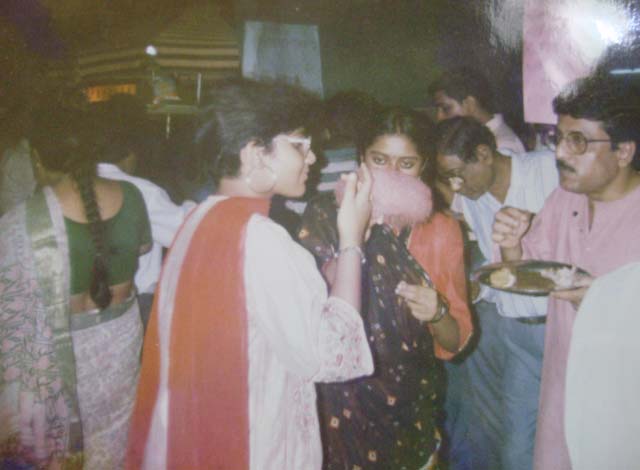
Calcutta Food Memory:
The one thing I remember about street food was the food available during Durga Puja…we were brought up in Maddox square which is like the ‘in place’ for Durga Puja celebration and Durga Puja is not complete without the various street food available at each of these puja pandals…..
My memories are mostly with my dad – he used to believe that street food is not worthy of its name unless it guarantees you falling sick! so as a kid I remember going with him to each of the stalls in Maddox Square – during those days Maddox Square Pujas we all knew each other including even the street food vendors – and our question to them was, “So what spoilt food have you made today and what illness will I have post eating this?”
Of course those vendors would state that their food was the freshest and would never make us fall sick…but if that was the answer they gave, my dad would refuse to buy the food. So to get their buyer those poor vendors would guarantee my dad that the food was bad and stale and we would have at least a stomach upset if not jaundice…and only then would we eat that food !
Kriti Mukherjee, foodie and independent consultant, New York, blogs at kriti-howaboutthis.blogspot.com
She writes about the power of food in families in Bengal, how it brings them together and also causes some colorful arguments…
The Ritual of Bengali Food (with a pinch of salt)
By Kriti Mukherjee
Kolkata in Brooklyn with Mukti Banerjee
O Calcutta may be very far from America but the good news is you can get your Bengali food fix right here! Actually you don’t have to even go to Kolkatta – you can get some Bengali treats in Brooklyn from Mukti Bannerjee’s catering service, along with many other Indian dishes.
Hankering for delicious tadka dal, egg curry and alu paratha? Take a walk to Mukti’s Kitchen in Brooklyn, and even learn how to cook the dishes in a meetup with other foodies. Mukti Banerjee is a home cook who for years cooked for family and friends and finally decided to share her treats with the larger world.
There’s a regular meetup (http://www.meetup.com/MuktisKitchen/) where you can connect with like-minded folk, listen to Indian music, learn some authentic recipes and actually taste them over a glass of wine.
In these cooking classes you don’t just watch and take notes – you actually get to cook in an interactive atmosphere. “Mukti shared with us her passion for creating delectable gourmet Indian dishes from scratch and was very methodical about explaining each step of the process,” says JingLin Huang, one of the attendees. “And if you’re too busy to cook, you can also order takeout or cater for parties. The group has both Indian and non-Indian members, united by a common hunger for Indian food.
Q and A with Mukti Banerjee of Mukti’s Kitchen
Q: How did you learn cooking – from mother and grandma, or by trial and error in NY?
I refined my Indian cooking mostly by trial and error in USA. However, my aunts from father’s side were really great cook. It runs in the family.
2. Which is your family’s favorite dish?
Small-fish curry, lentils and friend cauliflower over white rice would be one example. We all love it.
3. In Mukti’s Kitchen what are the dishes you teach your students?
I’ve taught dozens of North Indian dishes to my students: vegetarian, non-vegetarian, meat, fish, eggs…then you have roti, paratha, puri, biryani, fried rice…and appetizers such as samosa and pakora, and finally different varieties of Indian desserts. I’ve taught them how to make South Indian Dosa too.
4. What would be the authentic Bengali meal that you would make?
A typical, simple meal would be white rice, saag (greens such as spinach), lentils, a vegetable dish such as cauliflower, eggplant or okra preparation, and fish. A fancy meal on special occasions would add a meat curry, cutlets or rolls made of chicken or tuna fish, chutney and dessert such as the famous Bengali Rasa Golla or Sandesh. On birthdays, it would be Payesh (custard).
5. What dish do you miss the most, living in New York?
Perhaps an authentic Mughlai Paratha from the famous little Anadi Cabin or Rally Singh’s rice noodle kulfi would be great to have.
6. If people want to cater, how much earlier do they have to place their order?
Normally, a couple of days’ advanced request is great. If it’s a really big order, I need a week perhaps.
Some virtual meals from Mukti’s Kitchen…
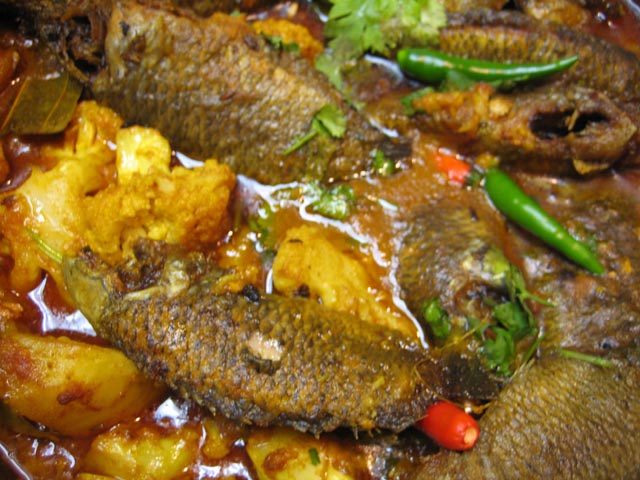
Koi Fish with Cauliflower and Potato
(Koi is a smaller but [perhaps] tastier Indian Tilapia)
Prep Time: 10 minutes
Cooking time: 30 minutes
Yield: 4 servings
Ingredients:
1 block Koi Fish (get it in Bangladeshi stores: comes in block)
1 whole cauliflower
1 large potato
1/4 cup vegetable oil
2 medium red onions
1-inch fresh ginger
2 cloves of garlic
1-teaspoon cumin powder
1/2-teaspoon coriander powder
¼ teaspoon turmeric powder
¼ teaspoon three-spice mix (cumin, coriander and clove in equal quantity)
¼ teaspoon five-spice mix called “Panch Phoron” (cumin, coriander, black cumin, mustard, fenugreek in equal quantity)
1 Bay leaf
Handful of coriander leaves
½ tablespoon of tomato paste
Salt to taste
Pinch of sugar
Three green chilies (optional)
½ cup water
Directions:
1. Thaw the fish overnight, drain the water, add one table spoon of salt and rub the fish; then wash it thoroughly to get rid of any fishy smell, add some salt and turmeric powder.
2. In a big wok heat the oil, let it warm until you see some fumes, fry your fish, add 3-4 at a time and fry them until they are brownish on both sides. Keep them aside.
3. In that same oil fry the cauliflower (in small florets) and potato (small cubes). Keep them aside.
4. You have some oil left; in it add three spices, let the aroma come, add onions (chopped), let them fry until brownish
5. In a blender add the onion, ginger, garlic tomato paste; coriander leaves (also called cilantro) with little water; blend them thoroughly.
6. In that wok add little oil, add the bay leaf, add ¼ teaspoon of the five-spice mix, let the aroma come, add the blended masala in your oil, add cumin powder, coriander powder and turmeric powder. Let it cook until your masala and oil separate.
7. Add 1/2 cup water and add your fish, cauliflower and potato, and green chilies
8. Let it cook for 5-6 minutes.
9. Add salt and little sugar to taste.
Enjoy with white rice
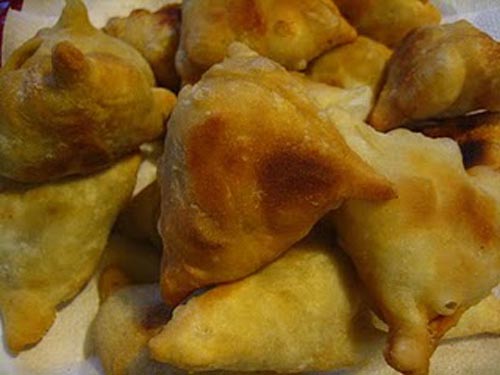
North Indian Samosa
Prep Time: 30 minutes
Cooking time: 20 minutes
Yield: 4 servings
Ingredients:
½ cup all purpose flour
2 cups of vegetable oil
¼ teaspoon of baking powder
Salt to taste
1 tablespoon of three-spice mix (cumin, coriander and clove in equal quantity)
½ teaspoon of cumin powder
½ teaspoon of coriander powder
¼ teaspoon of turmeric powder
Pinch of asafoetida
¼ cup of peas
Directions:
1. Boil three whole potatoes in a pressure cooker with little salt and baking powder (it helps to boil faster); keep them aside.
2. In a clean frying pan add 1 tablespoon of vegetable oil, let it warm, add pinch of asafoetida and ¼ teaspoon of three spice mix, let the aroma come.
3. Add your boiled potato with their skin on and mash them.
4. Add ½ teaspoon of cumin powder,½ teaspoon of coriander, ¼ teaspoon of turmeric powder add salt to taste, ¼ cup of peas
5. Fry for 5-6 min and mix them together (this is your stuffing, you can make different stuffing as for example, cauliflower and potato
or with chicken etc) let it cool.
6. In a bowl take the all purpose flour, add 1 teaspoon of roasted cumin, coriander and clove mix, add pinch of baking powder and two tablespoon of vegetable oil, make a dough by adding warm water slowly.
7. Roll your dough a big circle and cut in half, take half in your hand and make a cone shape, stuff your potato stuffing inside and seal the edges with water and flour (make a mixture which should look like a glue); make sure they are all sealed well before you put them in heated oil.
8. Deep fry them in moderate heat; it should look brown on the outside.
Drain extra oil on putting them on a paper towel.
Enjoy with mint coriander and tamarind chutney
(Illustration: Dipanjan Bose)
A Bengali food related short story: Ahididi’s Friends

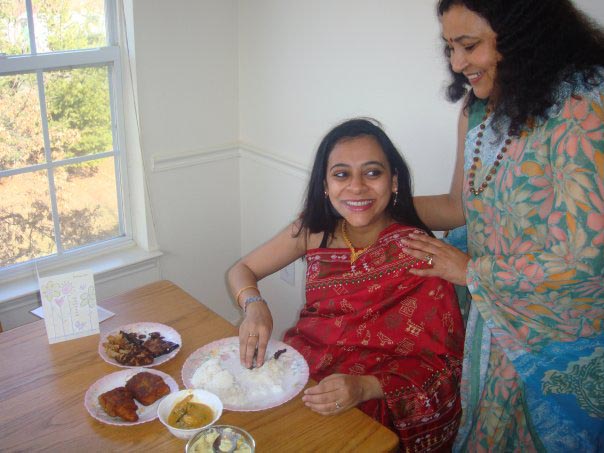
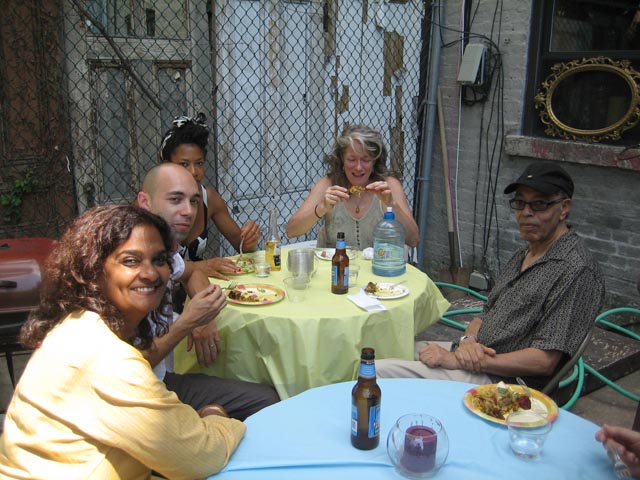
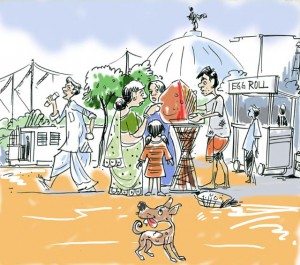
25 Comments
This article has really made me think and that’s the kind of writing I enjoy reading the most. Thank you for this well written material and information.
Divya, I knew the tantalizing aromas would bring you here! I think your recipes are really wonderful – you’ll have to do a guest blog for me with some of your spicy Thai food.
Sulekha, loved you comment – next time you come for lassi, bring in some phuchkas!!
Thank you Lavina for this lovely write up and also for making me share Lassi with Lavina via my facebook comment ,with you on your wonderful site.
Wow…..what a fantastic website………I’m loving the recipes!!!
Do check out all my tried and tested recipes at my food blog – addictedfoodie.blogspot.com
Via Facebook
Enjoyed reading this wonderful article and suddenly I have this craving for fish…must have fish now. Loved Priyashmita and Kriti’s contribution to Lavina’s great article….nice 🙂
Veronique, thanks for sharing your experiences!
Thanks Lavina! Will check your link out. That should be fun. Keep these coming please : )
If you are thinking about learning the best of Indian cooking, this is the place! At Mukti’s Kitchen in Brooklyn, you get in few hours the best tips to cook a gourmet Indian dish including great specialties from Kolkata and will be able to surprise your family members or friends. Learning the secrets of Indian dishes with simplicity is what Mukti teaches with a big smile in her face, an open heart and in a very friendly environment. I recommend to all food lovers to pass by at least once, you will be nicely surprised. Her food is as spicy as one may wish, very healthy and so easy to learn. I never thought that I would reconciliate myself with eggplants until my first class with Mukti!
Kriti – loved your reflections on the rituals of food – it really shows the complexity of Indian food and the stories behind it. I had earlier done a piece on dal – lentils – and had gathered some fascinating rituals behind something as ordinary as dal. That posting is at https://www.lassiwithlavina.com/foodieheavan/sustainer-of-life/html
Hi Alpana – we all have our street food memories – be it in Calcutta, Delhi or Bombay – or any part of India, for that matter. Street food is what binds us as a nation!
Thank you Tapas Mukherjee for your comments – and the great anecdote! I love the story – it just shows the creativity of these street vendors and how they can turn mundane ingredients into a remembered treat. Personally I think anything is enhanced with the addition of chopped onion.
Thank you for sharing something so wonderful with us, it’s like walking down memory lane. And Kriti…thank you to you and your mom for these awesome recipes..they are something to be treasured.
Shomik, I’m sure there are many Bangladeshi restaurants and 6th Street must surely have Bengali food. Anybody has any favorites? And you can cater from Mukti’s Kitchen.
Hi Nina, I was away at a seminar and came back to the blog to see all these comments – love them! Lassi with Lavina is about telling a billion stories so it’s great to get real people to tell real stories – not just celeb interviews or profiles but what our neighbors and friends are eating, sharing their memories of a beautiful city like Calcutta.
Actually the clubs are always great for that diverse mix of dishes.
Well said, Arijit – once a Kolkata boy, always a Kolkata boy. Like I’ll always be a Delhi girl – it’s the childhood days which are the sweetest.
Omkar,I’m sure you’ve been able to get some Bengali treats in Delhi? However, ‘pity those who haven’t got a taste of these’ is a pretty strong comment and makes me want to definitely try the puchkas at Vivekananda Park – next time when I’m in Cal – I mean Kolkata.
Thanks for your comments, Swati! We all love street foods – I went to Kolkata when it was still Calcutta and my cousins who live near New Market fed me the delicious Nizam rolls – street foods remain on the tongue forever!
The very act of reading these reminds me of my Kolkata days and makes me hungry. Anyone serving Bengali cuisine here in the Tri-state area?
I LOVED finding so many familiar names among the authors of this piece! WOW, what a fantastic load of info. Thank you Ladies! Also love the intro drawing above and all the photos. Thanks Lavina for sharing this wonderful piece with us!
As a one-time visitor to Calcutta – sorry I still also call Mumbai Bombay – I loved the fish dishes and sweets indeed! But I also still crave, deep down in my heart and soul, the Indo-Chinese dishes I had with a friend on the lawn of a private club near the Oberoi Hotel. What a great combo of spices, great DRY dishes – not chock full of gravies I don’t enjoy as much – and the chicken skewers with melted cheese on top, loaded with green chilies were the stuff dreams are made of! Could I find that in NY??
Nothing like food (and memories of food) to get a Bengali all worked up. Enjoyed reading this. It captured the essence of being Bengali through things that define us. You can take a boy out of Kolkata but you can’t take the Kolkata out of a boy. Cheers
Grt. reading it…Nostalgic feeling…Being a Bengali currently a probashi based in Delhi , it’s a sentimental feeling as always..loved the puchkas at Vivekananda Park , the Illish Bhapa and the Koi Jhol…oh…it’s amazing..pity those who haven’t got a taste of these… carry on, and one should keep the Bengali cuisine and delicacies flag flying…Cheers!!
Lavina, what a fantastic collection!! The one thing I miss about Calcutta is the street food, I crave it….I’m a Bong, but don’t like fish and that never ceases to amaze people. How can a Bong not eat fish?? But I loved your post and the recipes in it…thanks for sharing…
Thanks Lavina for an admirable collection, collation and presentation of Kolkata food facts. Kolkata indeed will be bereft of its character without its street food.
That reminds me of a personal experience. I once coaxed and cajoled an avowedly ‘bread-n-egg’ vendor to think of something new to offer other than two slices of toasted, or rather roasted bread on open flame, and an omelet or boiled or poached egg.
“That will cost you a little more,” he said sheepishly. I was game. The ingenuous man half-boiled an egg, spread it on one buttered bread with an iota of cheese, added chopped onion and a dash of ginger, sprinkled black salt and black pepper powder on it, and offered me what he described as a “juicy egg sandwich.” The result was quite exhilarating.
Wow Lavina, I am so honored to find place in “Lassi with Lavina”. This is the most informative and precise write-up on Bengali Food. Didn’t know about Mukti’s kitchen – that’s going to be my next exploration point. Thank you so very much for this article.